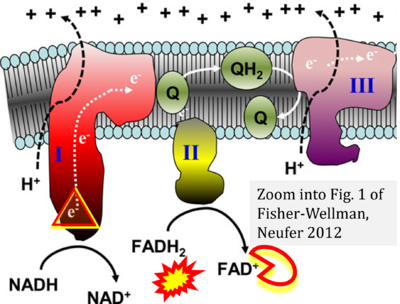Fisher-Wellman 2012 Trends Endocrinol Metab: Difference between revisions
No edit summary |
No edit summary |
||
| Line 8: | Line 8: | ||
|editor=Gnaiger E | |editor=Gnaiger E | ||
}} | }} | ||
[[File:Fisher-Wellman 2012 Trends Endocrinol Metab CORRECTION.png|400px|right]] | |||
{{Template:Correction FADH2 and S-pathway}} | |||
: | |||
{{Labeling | {{Labeling | ||
Revision as of 13:47, 19 March 2023
| Fisher-Wellman KH, Neufer PD (2012) Linking mitochondrial bioenergetics to insulin resistance via redox biology. Trends Endocrinol Metab 23:142-53. doi: 10.1016/j.tem.2011.12.008 |
Fisher-Wellman KH, Neufer PD (2012) Trends Endocrinol Metab
Abstract: Chronic overnutrition and physical inactivity are major risk factors for insulin resistance and type 2 diabetes. Recent research indicates that overnutrition generates an increase in hydrogen peroxide (H2O2) emission from mitochondria, serving as a release valve to relieve the reducing pressure created by fuel overload, as well as a primary signal that ultimately decreases insulin sensitivity. H(2)O(2) is a major input to cellular redox circuits that link to cysteine residues throughout the entire proteome to regulate cell function. Here we review the principles of mitochondrial bioenergetics and redox systems biology and offer new insight into how H(2)O(2) emission may be linked via redox biology to the etiology of insulin resistance.
• Bioblast editor: Gnaiger E
Correction: FADH2 and Complex II
- FADH2 is shown as the substrate feeding electrons into Complex II (CII). This is wrong and requires correction - for details see Gnaiger (2024).
- Gnaiger E (2024) Complex II ambiguities ― FADH2 in the electron transfer system. J Biol Chem 300:105470. https://doi.org/10.1016/j.jbc.2023.105470 - »Bioblast link«
Labels:
Pathology: Diabetes, Obesity
Stress:Oxidative stress;RONS
Regulation: Redox state


